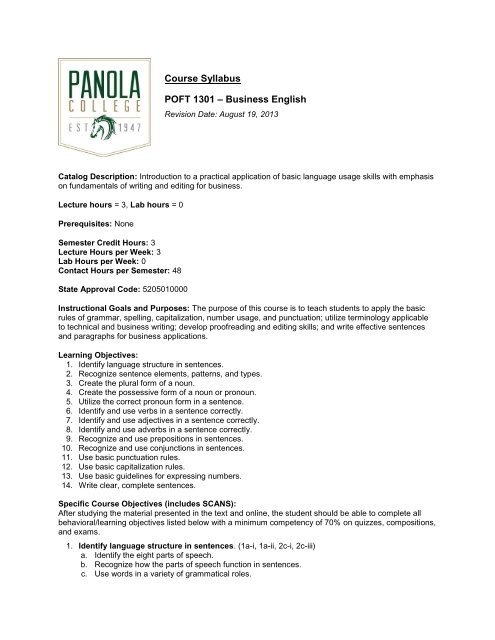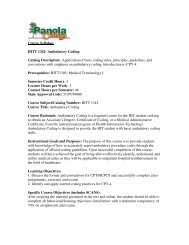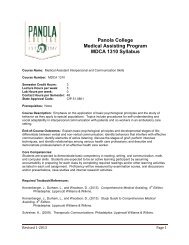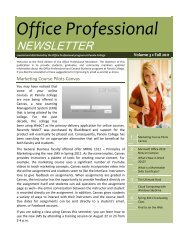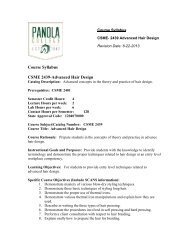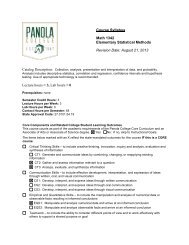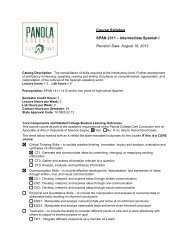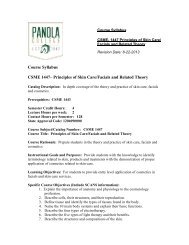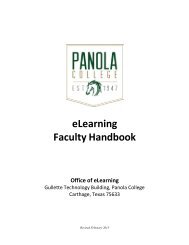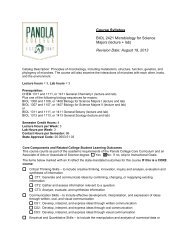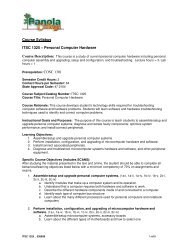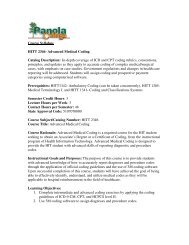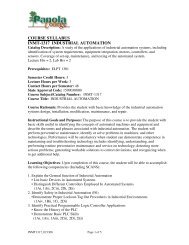Course Syllabus POFT 1301 â Business English - Panola College
Course Syllabus POFT 1301 â Business English - Panola College
Course Syllabus POFT 1301 â Business English - Panola College
You also want an ePaper? Increase the reach of your titles
YUMPU automatically turns print PDFs into web optimized ePapers that Google loves.
<strong>Course</strong> <strong>Syllabus</strong><br />
<strong>POFT</strong> <strong>1301</strong> – <strong>Business</strong> <strong>English</strong><br />
Revision Date: August 19, 2013<br />
Catalog Description: Introduction to a practical application of basic language usage skills with emphasis<br />
on fundamentals of writing and editing for business.<br />
Lecture hours = 3, Lab hours = 0<br />
Prerequisites: None<br />
Semester Credit Hours: 3<br />
Lecture Hours per Week: 3<br />
Lab Hours per Week: 0<br />
Contact Hours per Semester: 48<br />
State Approval Code: 5205010000<br />
Instructional Goals and Purposes: The purpose of this course is to teach students to apply the basic<br />
rules of grammar, spelling, capitalization, number usage, and punctuation; utilize terminology applicable<br />
to technical and business writing; develop proofreading and editing skills; and write effective sentences<br />
and paragraphs for business applications.<br />
Learning Objectives:<br />
1. Identify language structure in sentences.<br />
2. Recognize sentence elements, patterns, and types.<br />
3. Create the plural form of a noun.<br />
4. Create the possessive form of a noun or pronoun.<br />
5. Utilize the correct pronoun form in a sentence.<br />
6. Identify and use verbs in a sentence correctly.<br />
7. Identify and use adjectives in a sentence correctly.<br />
8. Identify and use adverbs in a sentence correctly.<br />
9. Recognize and use prepositions in sentences.<br />
10. Recognize and use conjunctions in sentences.<br />
11. Use basic punctuation rules.<br />
12. Use basic capitalization rules.<br />
13. Use basic guidelines for expressing numbers.<br />
14. Write clear, complete sentences.<br />
Specific <strong>Course</strong> Objectives (includes SCANS):<br />
After studying the material presented in the text and online, the student should be able to complete all<br />
behavioral/learning objectives listed below with a minimum competency of 70% on quizzes, compositions,<br />
and exams.<br />
1. Identify language structure in sentences. (1a-i, 1a-ii, 2c-i, 2c-iii)<br />
a. Identify the eight parts of speech.<br />
b. Recognize how the parts of speech function in sentences.<br />
c. Use words in a variety of grammatical roles.
2. Recognize sentence elements, patterns, and types. (1a-i, 1a-ii, 1b-iii, 1b-vi, 1c-i)<br />
a. Recognize basic sentence elements including subjects and predicates.<br />
b. Differentiate among phrases, dependent clauses, and independent clauses.<br />
c. Understand how to use simple, compound, complex, and compound-complex sentences.<br />
d. Identify four basic sentence patterns.<br />
e. Punctuate statements, commands, questions, and exclamations.<br />
f. Use techniques to avoid basic sentence faults such as fragments, comma splices, and run-on<br />
sentences.<br />
3. Create the plural form of a noun. (1b-iii, 1b-vi, 2c-i, 2c-ii)<br />
a. Distinguish between proper and common nouns.<br />
b. State the basic rules for forming the plurals of most nouns.<br />
c. Make regular and irregular nouns plural.<br />
d. Spell correctly the plural form of nouns ending in y, o, and f; proper nouns; surnames;<br />
compound nouns; and numerals, letters, degrees, and abbreviations.<br />
e. Make challenging nouns plural, including foreign nouns and special nouns.<br />
4. Create the possessive form of a noun or pronoun. (1a-i, 1b-iii, 1b-vi, 1c-i, 2c-i, 2c-ii, 2c-iii)<br />
a. Summarize the basic rules of forming the possessives of nouns.<br />
b. Use steps to apply an apostrophe to correctly show possession.<br />
c. Distinguish between descriptive nouns and possessive nouns.<br />
d. Create correct possessive forms of compound nouns, organizations, names, abbreviations, of<br />
nouns showing joint ownership, and of nouns showing individual ownership.<br />
5. Utilize the correct pronoun form in a sentence. (1b-iii, 1b-vi, 1c-iii, 2b-vi, 2c-i, 2c-iii)<br />
a. Use subjective, objective, and possessive pronouns correctly.<br />
b. Distinguish between personal possessive pronouns (such as its) and contractions (such as it’s).<br />
c. Choose the correct pronoun in compound constructions, comparatives, appositives, reflexives,<br />
and as complements following linking verbs.<br />
d. Make pronoun references clear, and ensure that personal pronouns agree with their<br />
antecedents in number and gender.<br />
e. Choose alternatives to common-gender antecedents.<br />
f. Make personal pronouns agree with subjects joined by or or nor, indefinite pronouns, collective<br />
nouns, company and organization names, and the adjectives each and every.<br />
g. Recognize the functions of who, whom, whoever, and whomever, and follow steps to use these<br />
words correctly in a sentence.<br />
6. Identify and use verbs in a sentence correctly. (1a-i, 1a-ii, 1b-iii, 1b-vi, 2c-i, 2c-iii)<br />
a. Identify verbs and verb phrases in sentences, including sentences that are inverted in order.<br />
b. Distinguish between transitive and intransitive verbs.<br />
c. Recognize active and passive voice verbs.<br />
d. Convert sentences written in passive voice to sentences in the active voice.<br />
e. Construct verbs in the present, past, and future tenses correctly.<br />
f. Recognize and use present and past participles.<br />
g. Recognize gerunds and supply appropriate modifiers of gerunds.<br />
h. Identify and remedy split infinitives.<br />
i. Correctly punctuate introductory and other verbal phrases.<br />
j. Rewrite sentences to eliminate awkward participial phrases.<br />
k. Locate dangling verbal phrases and other misplaced modifiers.<br />
l. Rewrite sentences to avoid misplaced verbal phrases and modifiers.<br />
m. Supply correct verb forms in the progressive and perfect tenses.<br />
n. Recognize sentence constructions requiring the subjunctive verb mood.<br />
o. Create sentences using the subjunctive mood correctly.<br />
p. Identify and write the correct forms of irregular verbs in sentences.<br />
q. Locate the subjects of verbs.<br />
r. Make verbs agree with true subjects.<br />
s. Make verbs agree with subjects joined by and, or, and nor.<br />
t. Select the correct verbs to agree with collective nouns and indefinite pronouns.<br />
u. Make verbs agree with quantities, fractions, portions, clauses, and a number/the number.<br />
v. Achieve subject-verb agreement within who clauses.<br />
2
7. Identify and use adjectives in a sentence correctly. (1a-ii, 1b-vi, 2c-iii)<br />
a. Form the comparative and superlative degrees of regular and irregular adjectives.<br />
b. Use articles correctly.<br />
c. Use adjectives after linking verbs.<br />
d. Punctuate compound and successive independent adjectives correctly.<br />
8. Identify and use adverbs in a sentence correctly. (1a-ii, 1b-iii, 1b-vi, 2c-iii)<br />
a. Form the comparative and superlative degrees of adverbs.<br />
b. Avoid double negatives when using adverbs in a sentence.<br />
c. Use adverbs to modify verbs, adjectives, and other adverbs within a sentence.<br />
d. Identify pitfalls in the use of adverbs.<br />
9. Recognize and use prepositions in sentences. (1a-ii, 1b-iii, 1b-vi, 2c-i, 2c-iii)<br />
a. Identify prepositional phrases and label the preposition and its object(s) in each phrase.<br />
b. Avoid using prepositions in place of verbs and adverbs.<br />
c. Use troublesome prepositions correctly.<br />
d. Omit unnecessary prepositions and retain necessary ones within sentences.<br />
e. Construct formal sentences that avoid terminal prepositions.<br />
f. Recognize those words and constructions requiring specific prepositions (idioms).<br />
10. Recognize and use conjunctions in sentences. (1a-ii, 1b-vi, 2c-iii)<br />
a. Distinguish between simple and compound sentences.<br />
b. Punctuate compound sentences joined by and, or, nor, and but.<br />
c. Punctuate compounds sentences using conjunctive adverbs, such as therefore, however, and<br />
consequently.<br />
d. Recognize correlative conjunctions, such as either . . . or, not only . . . but also, and neither . . .<br />
nor.<br />
e. Use a parallel construction in composing sentences with correlative conjunctions.<br />
f. Distinguish among phrases, dependent clauses, and independent clauses.<br />
g. Expand dependent clauses into complete sentences.<br />
h. Punctuate introductory and terminal dependent clauses.<br />
i. Punctuate parenthetical, essential, and nonessential dependent clauses.<br />
j. Recognize simple, compound, complex, and compound-complex sentence patterns.<br />
k. Convert simple sentences into a variety of more complex patterns.<br />
11. Use basic punctuation rules. (1a-i, 1a-ii, 1b-iii, 1b-vi, 2c-iii)<br />
a. Insert commas correctly in series, direct address, and parenthetical expressions.<br />
b. Punctuate dates, addresses, geographical items, and appositives correctly.<br />
c. Place commas appropriately in punctuating independent adjectives, verbal phrases, and<br />
prepositional phrases.<br />
d. Use commas correctly in punctuating independent, introductory, terminal, and nonessential<br />
clauses.<br />
e. Use commas correctly in punctuating degrees, abbreviations, and numerals.<br />
f. Use commas to indicate omitted words, contrasting statements, clarity, and short quotations.<br />
g. Identify and correct errors in comma usage.<br />
h. Use semicolons correctly to join independent clauses; correct errors in such usage.<br />
i. Use semicolons correctly before enumerations and explanations; correct errors in usage.<br />
j. Use colons correctly to introduce an independent clause and to emphasize words and<br />
thoughts.<br />
k. Capitalize the first word following a colon.<br />
l. Use dashes correctly in sentences.<br />
m. Use quotation marks correctly for direct quotations, definitions, special expressions, unfamiliar<br />
terms, and titles of articles.<br />
n. Combine other punctuation marks correctly with quotation marks in sentences.<br />
12. Use basic capitalization rules. (1a-i, 1a-ii, 1b-vi)<br />
a. Use capitals correctly for the first words of sentences, direct quotations, and items in outlines.<br />
b. Use capitals correctly in headings and in titles of publications.<br />
c. Capitalize correctly proper nouns, short forms used for proper nouns, personal and official titles<br />
used with proper names, and proper adjectives.<br />
3
d. Capitalize correctly the names of commercial products.<br />
e. Correct errors in capitalization usage.<br />
13. Use basic guidelines for expressing numbers. (1a-i, 1a-ii, 1b-vi)<br />
a. Correctly choose between figure and word forms to express general numbers, money, and<br />
numbers beginning sentences.<br />
b. Express dates, clock time, addresses, and telephone numbers appropriately.<br />
c. Use the correct form in writing related numbers, consecutive numbers, periods of time, and<br />
ages.<br />
d. Use the correct form in expressing numbers in conventional phrases, with abbreviations and<br />
symbols, and as round numbers.<br />
e. Express weights, measures, and fractions correctly.<br />
f. Use the correct form in expressing percentages, decimals, and ordinals.<br />
14. Write clear, complete sentences. (1a-i, 1a-ii, 1b-iii, 1b-v, 1b-vi, 2c-iv)<br />
a. Compose sentences that are grammatically correct.<br />
b. Compose sentences that are punctuated correctly.<br />
c. Compose sentences that express a clear thought.<br />
d. Avoid fragments, run-on sentences, comma splices, and period faults.<br />
e. Proofread sentences for errors.<br />
<strong>Course</strong> Content:<br />
Students in all sections of <strong>Business</strong> <strong>English</strong> will be required to do the following:<br />
1. Students will read assigned chapters in the text and complete an online quiz for each chapter.<br />
2. Students will write and type compositions free of grammar and punctuation errors.<br />
3. Students will complete online objective exams in the presence of a testing proctor.<br />
Methods of Instruction/<strong>Course</strong> Format/Delivery: Students in both the traditional class and in the<br />
Internet class will have access to this course via Canvas. Students in the traditional class will meet<br />
regularly for lecture over the material. Students in the Internet class will only be required to meet with the<br />
instructor for testing; however, Internet students are always welcome to attend the traditional class<br />
(especially for exam reviews).<br />
All quizzes, compositions, and exams will be submitted through Canvas. After an assignment has<br />
been graded, the student will be able to view his or her grade by returning to the assignment or<br />
by clicking Grades in the left banner. Students will have limited review of the answers to the<br />
exams, but they will always be able to view the score. Work is generally graded and posted within<br />
two days following the deadline.<br />
Students in both the traditional and Internet classes should use People within Canvas to communicate<br />
with the instructor. Using Canvas email gives you access to the instructor and other classmates without<br />
having to remember or type email addresses—you just select a name from the list. If you are not able to<br />
contact your instructor using email in Canvas, you may use his or her <strong>Panola</strong> <strong>College</strong> email address.<br />
<strong>Panola</strong> <strong>College</strong> instructors attempt to respond to all email within 24 hours. Please always include a<br />
subject line and your name in your email.<br />
Assessment:<br />
The following items will be assigned during the semester and used to calculate the student’s final grade:<br />
<br />
<br />
ONLINE QUIZZES<br />
Approximately 10-15 quizzes will be given during the semester. The quizzes will be given online<br />
and you may use your textbook to complete them. Each quiz will have a deadline and failure to<br />
complete the quiz by the deadline will result in a zero for that quiz. The normal quiz includes 20-<br />
40 true/false and multiple choice questions. Your two lowest quiz grades will be dropped at the<br />
end of the semester.<br />
COMPOSITIONS<br />
Students will be required to complete several short composition exercises during the semester<br />
applying the rules covered in the text. These are compositions so there will be no research<br />
4
involved. Each composition must be written in the student’s own words and typed using a word<br />
processor—plagiarized work will receive a grade of zero. Internet students will submit their<br />
compositions by uploading them through Canvas. Ten points will be deducted for each day that a<br />
composition is submitted late and no submissions will be accepted after work has been returned<br />
to the class.<br />
EXAMS<br />
Four objective exams will be given during the semester (including the final exam), each covering<br />
selected chapters from the text. Traditional and Internet students must access the <strong>Syllabus</strong> or<br />
Calendar in Canvas each week to view the assignment and upcoming test dates. Students in the<br />
face-to-face class will take the exams during a regular scheduled class. All tests for Internet<br />
students will be administered by a proctor at the Carthage, Center, or Marshall sites.<br />
<strong>Course</strong> Grade:<br />
The grading scale for this course is as follows:<br />
Online quizzes – 20%<br />
Compositions – 20%<br />
Exams – 60%<br />
All student grades including a mid-semester and final grade will be posted to Grades in Canvas.<br />
Students needing special classroom or testing accommodations because of physical or learning<br />
disabilities must contact the Student Success office before these services will be made available in the<br />
classroom.<br />
A student that chooses to NOT finish the course must complete the withdrawal procedure in the Student<br />
Success office in order to receive a ―W.‖ Otherwise, the student will receive a grade at the end of the<br />
semester commensurate with the work completed.<br />
Texts, Materials, and Supplies:<br />
<strong>Business</strong> <strong>English</strong> 11 th Edition, Guffey and Seefer, 2014, South-Western, Cengage Learning,<br />
ISBN: 1133627501.<br />
Access to a computer, a word processor, and the Internet.<br />
Other:<br />
<br />
<br />
<br />
<br />
<br />
For current texts and materials, use the following link to access bookstore listings:<br />
http://www.panolacollegestore.com.<br />
For testing services, use the following link: http://www.panola.edu/elearning/testing.html.<br />
If any student in this class has special classroom or testing needs because of a physical learning<br />
or emotional condition, please contact the ADA Student Coordinator in Support Services located<br />
in the Administration Building or go to http://www.panola.edu/student-success/disability-supportservices/<br />
for more information.<br />
Withdrawing from a course is the student’s responsibility. Students who do not attend class and<br />
who do not withdraw will receive the grade earned for the course.<br />
Student Handbook, The Pathfinder: http://www.panola.edu/studentsuccess/documents/pathfinder.pdf<br />
5
SCANS CRITERIA<br />
1) Foundation skills are defined in three areas: basic skills, thinking skills, and personal<br />
qualities.<br />
a) Basic Skills: A worker must read, write, perform arithmetic and mathematical operations, listen,<br />
and speak effectively. These skills include:<br />
i) Reading: locate, understand, and interpret written information in prose and in documents<br />
such as manuals, graphs, and schedules.<br />
ii) Writing: communicate thoughts, ideas, information, and messages in writing, and create<br />
documents such as letters, directions, manuals, reports, graphs, and flow charts.<br />
iii) Arithmetic and Mathematical Operations: perform basic computations and approach practical<br />
problems by choosing appropriately from a variety of mathematical techniques.<br />
iv) Listening: receive, attend to, interpret, and respond to verbal messages and other cues.<br />
v) Speaking: Organize ideas and communicate orally.<br />
b) Thinking Skills: A worker must think creatively, make decisions, solve problems, visualize, know<br />
how to learn, and reason effectively. These skills include:<br />
i) Creative Thinking: generate new ideas.<br />
ii) Decision Making: specify goals and constraints, generate alternatives, consider risks, and<br />
evaluate and choose the best alternative.<br />
iii) Problem Solving: recognize problems and devise and implement plan of action.<br />
iv) Visualize ("Seeing Things in the Mind's Eye"): organize and process symbols, pictures,<br />
graphs, objects, and other information.<br />
v) Knowing How to Learn: use efficient learning techniques to acquire and apply new knowledge<br />
and skills.<br />
vi) Reasoning: discover a rule or principle underlying the relationship between two or more<br />
objects and apply it when solving a problem.<br />
c) Personal Qualities: A worker must display responsibility, self-esteem, sociability, selfmanagement,<br />
integrity, and honesty.<br />
i) Responsibility: exert a high level of effort and persevere toward goal attainment.<br />
ii) Self-Esteem: believe in one's own self-worth and maintain a positive view of oneself.<br />
iii) Sociability: demonstrate understanding, friendliness, adaptability, empathy, and politeness in<br />
group settings.<br />
iv) Self-Management: assess oneself accurately, set personal goals, monitor progress, and<br />
exhibit self-control.<br />
v) Integrity and Honesty: choose ethical courses of action.<br />
2) Workplace competencies are defined in five areas: resources, interpersonal skills,<br />
information, systems, and technology.<br />
a) Resources: A worker must identify, organize, plan, and allocate resources effectively.<br />
i) Time: select goal-relevant activities, rank them, allocate time, and prepare and follow<br />
schedules.<br />
ii) Money: Use or prepare budgets, make forecasts, keep records, and make adjustments to<br />
meet objectives.<br />
iii) Material and Facilities: Acquire, store, allocate, and use materials or space efficiently.<br />
Examples: construct a decision time line chart; use computer software to plan a project; prepare a<br />
budget; conduct a cost/benefits analysis; design an RFP process; write a job description; develop<br />
a staffing plan.<br />
b) Interpersonal Skills: A worker must work with others effectively.<br />
i) Participate as a Member of a Team: contribute to group effort.<br />
ii) Teach Others New Skills.<br />
iii) Serve Clients/Customers: work to satisfy customer's expectations.<br />
6
iv) Exercise Leadership: communicate ideas to justify position, persuade and convince others,<br />
responsibly challenge existing procedures and policies.<br />
v) Negotiate: work toward agreements involving exchange of resources, resolve divergent<br />
interests.<br />
vi) Work with Diversity: work well with men and women from diverse backgrounds.<br />
Examples: collaborate with a group member to solve a problem; work through a group conflict<br />
situation, train a colleague; deal with a dissatisfied customer in person; select and use<br />
appropriate leadership styles; use effective delegation techniques; conduct an individual or team<br />
negotiation; demonstrate an understanding of how people from different cultural backgrounds<br />
might behave in various situations.<br />
c) Information: A worker must be able to acquire and use information.<br />
i) Acquire and Evaluate Information.<br />
ii) Organize and Maintain Information.<br />
iii) Interpret and Communicate Information.<br />
iv) Use Computers to Process Information.<br />
Examples: research and collect data from various sources; develop a form to collect data;<br />
develop an inventory record-keeping system; produce a report using graphics; make an oral<br />
presentation using various media; use on-line computer data bases to research a report; use a<br />
computer spreadsheet to develop a budget.<br />
d) Systems: A worker must understand complex interrelationships.<br />
i) Understand Systems: know how social, organizational, and technological systems work and<br />
operate effectively with them.<br />
ii) Monitor and Correct Performance: distinguish trends, predict impacts on system operations,<br />
diagnose deviations in systems' performance and correct malfunctions.<br />
iii) Improve or Design Systems: suggest modifications to existing systems and develop new or<br />
alternative systems to improve performance.<br />
Examples: draw and interpret an organizational chart; develop a monitoring process; choose a<br />
situation needing improvement, break it down, examine it, propose an improvement, and<br />
implement it.<br />
e) Technology: A worker must be able to work with a variety of technologies.<br />
i) Select Technology: choose procedures, tools or equipment including computers and related<br />
technologies.<br />
ii) Apply Technologies to Task: understand overall intent and proper procedures for setup and<br />
operation of equipment.<br />
iii) Maintain and Troubleshoot Equipment: Prevent, identify, or solve problems with equipment,<br />
including computers and other technologies.<br />
Examples: read equipment descriptions and technical specifications to select equipment to meet<br />
needs; set up and assemble appropriate equipment from instructions; read and follow directions<br />
for troubleshooting and repairing equipment.<br />
7


